
Buffalo Soldiers were United States Army regiments composed exclusively of African Americans soldiers, formed during the 19th century to serve on the American frontier. On September 21, 1866, the 10th Cavalry Regiment was formed at Fort Leavenworth, Kansas. The nickname "Buffalo Soldiers" was purportedly given to the regiments by the American Indian tribes who fought against them during the American Indian Wars, and the term eventually became synonymous with all of the African American regiments that were established in 1866, including the 9th Cavalry Regiment, 10th Cavalry Regiment, 24th Infantry Regiment, 25th Infantry Regiment and 38th Infantry Regiment.

The Pancho Villa Expedition—now known officially in the United States as the Mexican Expedition, but originally referred to as the "Punitive Expedition, U.S. Army"—was a military operation conducted by the United States Army against the paramilitary forces of Mexican revolutionary Francisco "Pancho" Villa from March 14, 1916, to February 7, 1917, during the Mexican Revolution of 1910–1920.

Fort Huachuca is a United States Army installation, established on 3 March 1877 as Camp Huachuca. The garrison is now under the command of the United States Army Installation Management Command. It is in Cochise County in southeast Arizona, approximately 15 miles (24 km) north of the border with Mexico and at the northern end of the Huachuca Mountains, adjacent to the town of Sierra Vista. From 1913 to 1933, the fort was the base for the "Buffalo Soldiers" of the 10th Cavalry Regiment. During the build-up of World War II, the fort had quarters for more than 25,000 male soldiers and hundreds of WACs. In the 2010 census, Fort Huachuca had a population of about 6,500 active duty soldiers, 7,400 military family members, and 5,000 civilian employees. Fort Huachuca has over 18,000 people on post during weekday work hours.
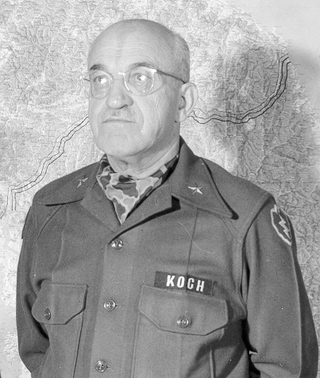
Oscar W. Koch was a brigadier general in the United States Army. He was most notable for his service as Third Army's Intelligence officer (G-2) under General George S. Patton in World War II.
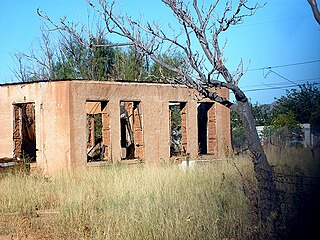
Fort Naco, Camp Naco, or Fort Newell began as a camp in the Southwest United States, on the outskirts of Naco, Arizona as part of the Mexican Border Project. Over time adobe and wooden buildings were constructed to house the garrison along with other permanent structures.
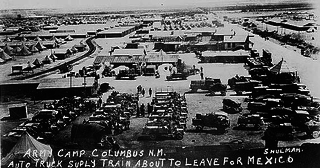
The Village of Columbus and Camp Furlong is a National Historic Landmark District commemorating the 1916 raid by Pancho Villa on the town of Columbus, New Mexico, and the American military response to that raid, the "Punitive Expedition" led by General John J. Pershing. The raid and its response, set during World War I, the Mexican Revolution, and an accompanying low-level Border War, played a significant role in diplomacy and military preparedness for eventual American entry in the World War. The district encompasses buildings that survived the raid, and military facilities used in the American response. The landmark designation was made in 1975.
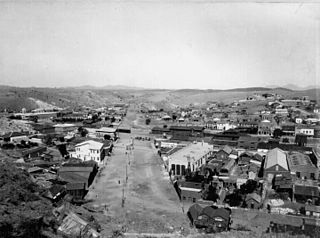
The Battle of Ambos Nogales, or as it is known in Mexico La batalla del 27 de agosto, was an engagement fought on 27 August 1918 between Mexican military and civilian militia forces and elements of U.S. Army troops of the 35th Infantry Regiment, who were reinforced by the Buffalo Soldiers of the 10th Cavalry Regiment, and commanded by Lt. Col. Frederick J. Herman. The American soldiers and militia forces were stationed in Nogales, Arizona, and the Mexican soldiers and armed Mexican militia were in Nogales, Sonora. This battle was notable for being a significant confrontation between U.S. and Mexican forces during the Border War, which took place in the context of the Mexican Revolution and the First World War.

The Battle of Columbus, March 9, 1916, began as a raid conducted by remnants of Pancho Villa's Division of the North on the small United States border town of Columbus, New Mexico, located 3 miles (4.8 km) north of the border with Mexico. The raid escalated into a full-scale battle between Villistas and the United States Army.

The Mexican Border War, or the Border Campaign, was a series of military engagements which took place in the Mexican–American border region of North America during the Mexican Revolution. The period of the war encompassed World War I, and the German Empire attempted to have Mexico attack the United States, as well as engaging in hostilities against American forces there itself.

The Second Battle of Nogales was a three-sided military engagement of the Mexican Revolution, fought in November 1915 at the border towns of Nogales, Sonora, and Nogales, Arizona. On the morning of November 26, rebel forces of Pancho Villa, who occupied Nogales, Sonora, began firing on United States Army soldiers in Nogales, Arizona. The Americans responded with counter fire for over two hours before a force of Carrancistas arrived to attack the Villistas. Later that day, the Constitutionalistas accidentally opened fire on American soldiers and another short skirmish was fought. The battle resulted in the deaths of several Mexicans and was the first significant engagement fought between Villistas and the United States military.
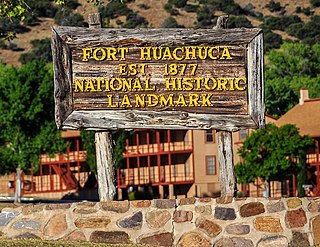
This is a list with images of some of the historic structures and places in the Fort Huachuca National Historic District in Arizona. The district, also known as Old Fort Huachuca, is located within Fort Huachuca an active United States Army installation under the command of the United States Army Installation Management Command. The fort sits at the base of the Huachuca Mountains four miles west of the town of Sierra Vista, on AZ 90 in Cochise County, Arizona.

Major General Frank L. Culin Jr. was a career officer in the United States Army. A recipient of the Army Distinguished Service Medal, Silver Star, Bronze Star Medal, and Air Medal, he was a veteran of both World War I and World War II. Culin attained the rank of major general and was most notable for his command of the 87th Infantry Division in the Ardennes Forest during the Battle of the Bulge in the final months of World War II.

Henry Rodney Adair (1882–1916) was an American cavalry officer. He is most notable for his participation in the Battle of Carrizal of the Pancho Villa Expedition.

John E. Woodward was a career officer in the United States Army. A veteran of the Spanish–American War, Philippine–American War, Moro Rebellion, Pancho Villa Expedition, and World War I, he served from 1892 to 1934 and attained the rank of brigadier general. Woodward was most notable for his command of the 113th Infantry Regiment, Camp Upton, 152d Depot Brigade, 24th Infantry Brigade, 151st Depot Brigade, and 12th Division.

Mathew Charles Smith was a career officer in the United States Army. An 1893 graduate of the United States Military Academy, he was a veteran of the Spanish–American War, Philippine–American War, the Pancho Villa Expedition, and World War I and served from 1893 to 1932. He attained the rank of brigadier general and his command assignments included the 129th Infantry Regiment, 309th Cavalry Regiment, 56th Field Artillery Regiment, 95th Division, and Panama Pacific General Depot.

John S. Winn, was a career officer in the United States Army. A veteran of the Spanish–American War, Philippine–American War, United States occupation of Veracruz, Pancho Villa Expedition, World War I, and the Occupation of the Rhineland, and he attained the rank of brigadier general. Winn commanded brigades in France during the First World War, and was a recipient of the Silver Star and the French Legion of Honor (Officer).
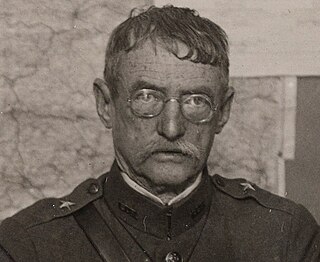
Robert Douglas Walsh was a career officer in the United States Army. An 1883 graduate of the United States Military Academy, he was a veteran of the American Indian Wars, Spanish–American War, Philippine–American War, Pancho Villa Expedition, and World War I. Walsh served until retiring in 1919, and was a recipient of the Army Distinguished Service Medal and French Legion of Honor (Commander).

Perry L. Miles was a career officer in the United States Army. A veteran of the Spanish–American War, Philippine–American War, Pancho Villa Expedition, and World War I, he attained the rank of brigadier general, and his awards and decorations included the Distinguished Service Cross, Army Distinguished Service Medal, Silver Star, and Purple Heart from the United States, as well as the French Legion of Honor (Officer) and Croix de Guerre with Palm.

James Augustine Ryan was a career officer in the United States Army. A veteran of the American Indian Wars, Spanish–American War, Philippine–American War, Pancho Villa Expedition, and World War I, he attained the rank of brigadier general. During the First World War, Ryan commanded 1st Brigade, 15th Cavalry Division at Fort Sam Houston, Texas, and 17th Brigade, 9th Division at Camp Sheridan, Alabama, in addition to acting as the 9th Division commander on several occasions.

Donald A. Stroh was a career officer in the United States Army. A veteran of World War I and World War II, he served from 1917 to 1949 and attained the rank of major general. Stroh's commands included the: 339th Infantry Regiment; 8th Infantry Division; 106th Infantry Division; Replacement Depot, Camp Pickett, Virginia; and Army Personnel Records Board. Stroh's awards included the Army Distinguished Service Medal, two awards of the Legion of Merit, and the Bronze Star Medal.




















